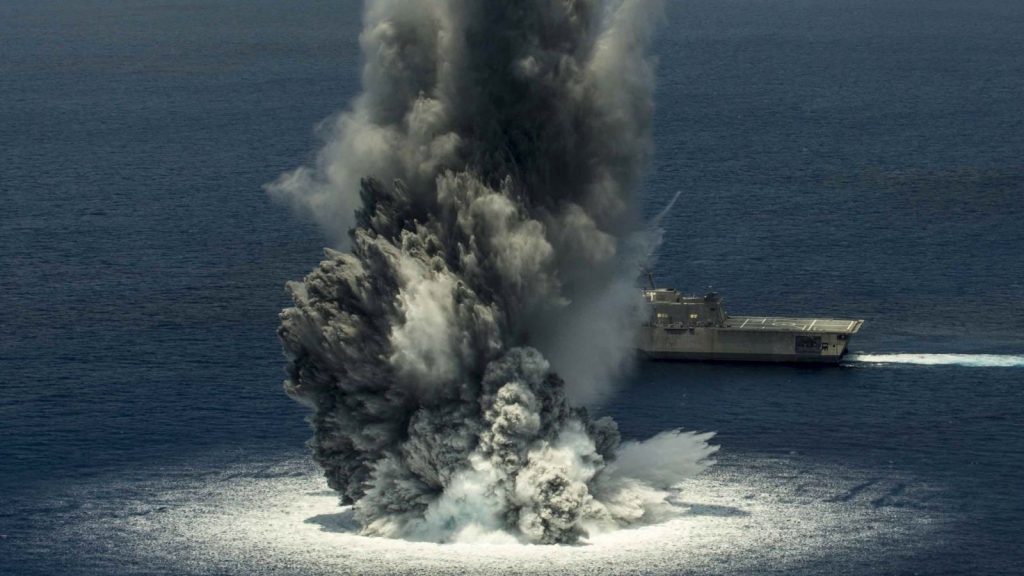16 October 2018–Underwater explosions detonated by the U.S. Navy to test the sturdiness of ships’ hulls have provided seismologists with a test opportunity of their own: how much can we know about an underwater explosion from the seismic and acoustic data it generates?
In a study published in the Bulletin of the Seismological Society of America, a team of researchers led by Ross Heyburn of AWE Blacknest in the United Kingdom compared the “ground-truth” data available from the Navy on the location, size and depth of these detonations to estimates obtained from seismic stations and hydroacoustic sensors.
The explosions conducted off the Florida coast offer a chance to test the capabilities of the International Monitoring System (IMS) of the Comprehensive Test-Ban Treaty Organization, deployed to detect secret nuclear test explosions, say the authors.
“Underwater explosions of this size where ground-truth data are available are quite rare,” said Heyburn. IMS stations “do record signals from many underwater events, both naturally occurring, like earthquakes, and man-made, like air-gun surveys. However, ground-truth data from the man-made sources are often not available, and usually any underwater explosions observed are much smaller in size than the Florida explosions.”
The Navy explosion tests were conducted in 2001, 2008 and 2016 within the Navy’s Mayport test area, located 120 kilometers off the coast of Jacksonville, Florida. The experiments tested the hull integrity of the near-shore combat ships the USS Jackson, the USS Milwaukee, the USS Winston Churchill and the USS Mesa Verde. During the experiments, 10,000-pound chemical explosions were towed behind a vessel sailing alongside the combat ships, to test how the combat ship hulls responded to the shock waves produced by nearby detonations equivalent to a TNT charge weight of about 6759 kilograms.

The explosions aren’t the size of a nuclear test explosion, but they are much larger than many of the other underwater explosions that are available to study, explained Heyburn. “The explosions described in the paper are much smaller than a typical nuclear test explosion which is typically of the order of kilotons in TNT equivalent charge weight,” he said. “For comparison, naval mines and anti-submarine depth charges typically contain explosive charges with TNT equivalent charge weights of the order of hundreds of kilograms.”
Heyburn and colleagues analyzed data from the explosions collected by IMS seismic stations around the globe and from a hydrophone station near Ascension Island in the South Atlantic Ocean for the tests in 2008 and 2016. The researchers used the location data provided by the Navy for several of the explosions as a way to improve the accuracy of calculations used to pinpoint the epicenter of explosions without available ground-truth data.
Previous research on detonations in the Dead Sea and other underwater test sites has shown that there is a relationship between the local magnitude of an explosion and its charge weight. After taking into account the salinity of the seawater near Florida, Heyburn and colleagues were able to modify the Dead Sea calculations to estimate the Navy charge weights from published estimates of local magnitude for the explosions.
Underwater explosions also produce unique seismic features that can be used to identify the source. One such notable feature is the bubble pulse, the underwater pulsing generated by the gas bubble created by the explosion as it expands and contracts in size. The researchers were able to identify the bubble pulse in the seismic records, confirming that the seismic signals were the result of an underwater explosion.
The bubble pulse was not observed as clearly at the Ascension Island hydrophone station, and Heyburn and colleagues suggest that the shallow waters off the Florida Coast may have distorted the hydroacoustic signals of the explosion. “This showed that both the seismic and hydroacoustic data can be important when analyzing signals from underwater explosions,” said Heyburn.
